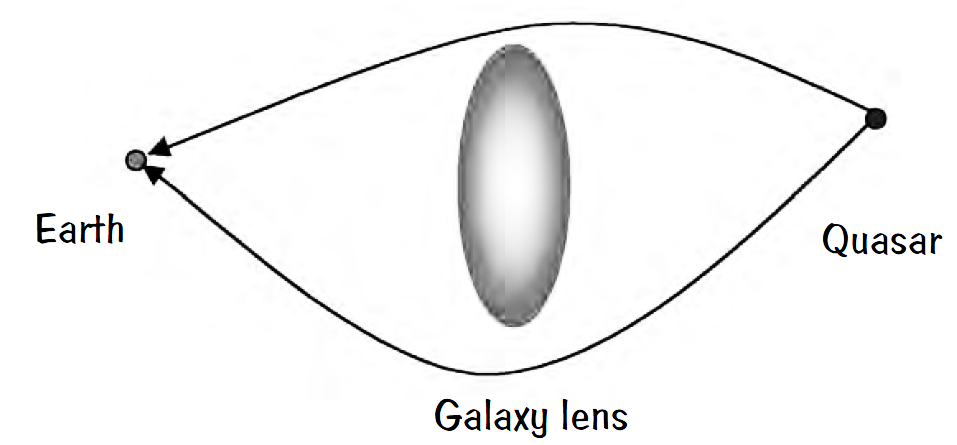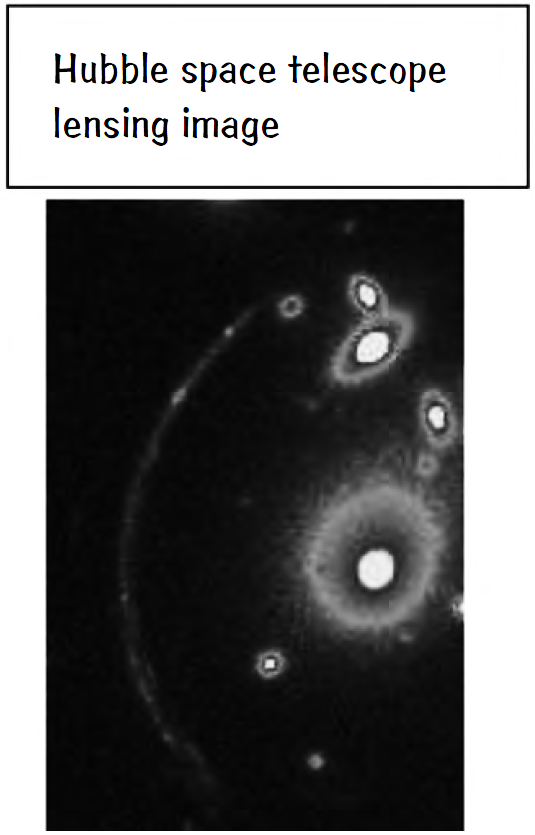


 الفيزياء الكلاسيكية
الفيزياء الكلاسيكية
 الكهربائية والمغناطيسية
الكهربائية والمغناطيسية
 علم البصريات
علم البصريات
 الفيزياء الحديثة
الفيزياء الحديثة
 النظرية النسبية
النظرية النسبية
 الفيزياء النووية
الفيزياء النووية
 فيزياء الحالة الصلبة
فيزياء الحالة الصلبة
 الليزر
الليزر
 علم الفلك
علم الفلك
 المجموعة الشمسية
المجموعة الشمسية
 الطاقة البديلة
الطاقة البديلة
 الفيزياء والعلوم الأخرى
الفيزياء والعلوم الأخرى
 مواضيع عامة في الفيزياء
مواضيع عامة في الفيزياء|
Read More
Date: 14-11-2016
Date: 14-11-2016
Date: 2-10-2016
|
Gravitational Lensing
In examining the universe, astronomers utilize a technique called gravitational lensing of the light from distance stars. Supposedly, space itself can act as a lens for light rays. How can the emptiness of space the vacuum itself around stars and galaxies focus light?

Answer
The general theory of relativity (GTR) tells us that all forms of energy are affected by a gravitational field, including the energy carried by photons of light. In the Schwarzschild metric surrounding a star, for example, the path of the light from a distant star is diverted toward the Sun from a straight-line path when passing near a massive body such as our Sun. Half of the deflection angle is caused by the Newtonian attraction of the Sun; the second half is caused by the geometrical modification, called curvature, of space by the Sun. Gravitational lensing ideas have been around for about 200 years, but only in the past decade or so has gravitational lensing played an important part in astronomical measurements.
If the intermediate massive body is a galaxy, then light from distance sources behind this galaxy will be focused somewhat by the two effects,

just like the light going through a glass lens is refracted to a focus. However, the geometry of the light focusing is much more complicated for gravitational lensing than for a simple symmetrical convex lens, for several reasons. The light may be focused onto a line instead of a point, for example, in an ideal case. Therefore, astronomers can use galaxies as lenses to gather more light from far objects better. The focus may be poor, but the greater intensity allows many spectroscopic techniques to work better.
Usually the image resolution of the distant object is quite limited by inhomogeneities in the intermediate galaxy. However, these properties of the intermediate galaxy can be examined quite well! In fact, if the classical application of the GTR to calculate the focusing effects in gravitational lensing is correct, then the total mass of the intermediate galaxy and its mass distribution can be determined. Galaxy masses determined with gravitational lensing have disagreed with the very successful proposal for a modified Newtonian dynamics (MOND) within a galaxy region and have supported the “dark matter” models. However, the game is not over for MOND because large-scale gravitational quantization, either from a version of M-theory and superstrings or from some other quantization scheme, may come to the rescue eventually.



|
|
|
|
مخاطر خفية لمكون شائع في مشروبات الطاقة والمكملات الغذائية
|
|
|
|
|
|
|
"آبل" تشغّل نظامها الجديد للذكاء الاصطناعي على أجهزتها
|
|
|
|
|
|
|
تستخدم لأول مرة... مستشفى الإمام زين العابدين (ع) التابع للعتبة الحسينية يعتمد تقنيات حديثة في تثبيت الكسور المعقدة
|
|
|